If you are looking for a trip of a lifetime, this is it! Our 5 day Darwin to Kakadu itinerary brings you the highlights of Northern Territory Australia.
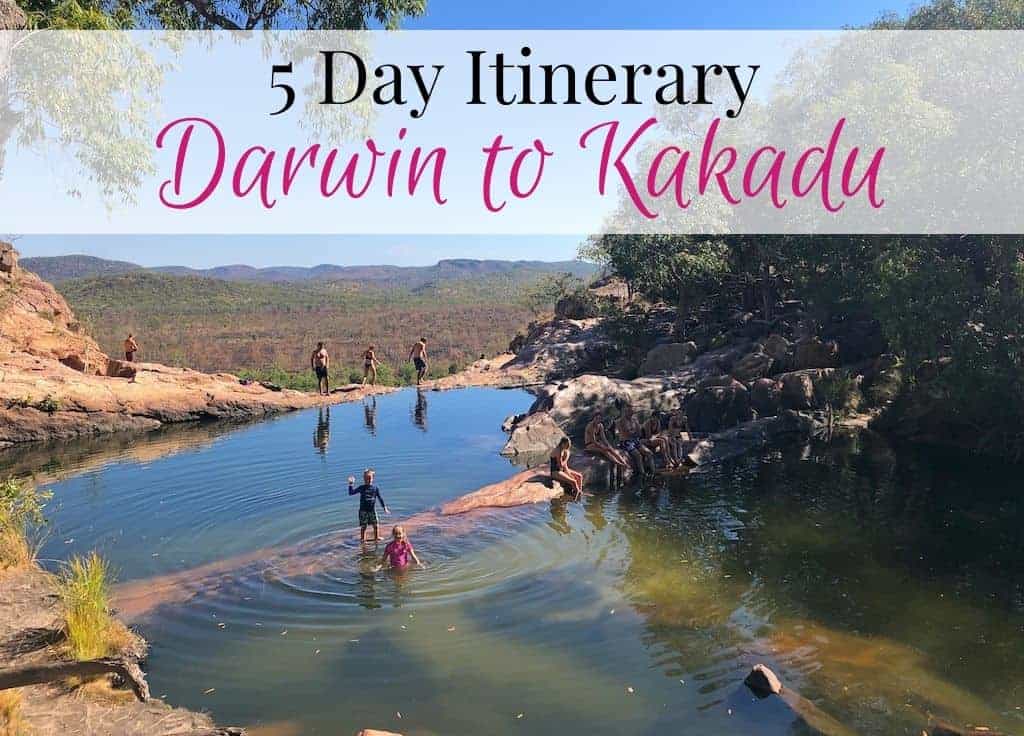
Visiting Kakadu National Park in Australia had always been a dream of mine, but I had no idea that there was so much to see and do in the surrounding Northern Territory area also.
The area is so incredibly beautiful and vast and our Darwin to Kakadu itinerary was filled with fun and diverse activities.
We swam in insanely beautiful natural swimming holes, kayaked through gorges alongside freshwater crocodiles, admired 20,000-year old rock art and saw an incredible amount of wildlife, including of course the ubiquitous saltwater crocodile.
If you are looking for a trip of a lifetime, this is it!
This Northern Territory tour takes in several of the Northern Territory national parks near Darwin: Litchfield, Nitmiluk, Kakadu and also includes a detour over into Arnhem Land.
Note that we did this itinerary as a private tour with a guide who did all of the driving. This meant we were able to fit a lot into our 5 day Kakadu itinerary.
If you are planning a self-drive Kakadu itinerary, I would really recommend adding an extra day or two to your travel plans, just to give yourselves some space. There was a lot of driving involved over difficult roads and there is a lot to fit in.
I have tried to be as detailed as possible, to give you lots of information if you are planning a self-drive Kakadu trip.
If you don’t want to self-drive, check out the following Northern Territory tours you can take:
Table of Contents
Darwin to Kakadu Itinerary Overview:
Day 1: Litchfield National Park
Day 2: Nitmiluk National Park & Katherine Gorge
Day 3: Katherine Hot Springs & Gunlom Falls, Kakadu
Day 4: Arnhem Land & Ubirr Rock, Kakadu
Day 5: Yellow Water Billabong Cruise & Maguk (Barramundi Gorge)
Our Darwin to Kakadu Driving Route Map
Day 1: Litchfield National Park Waterfalls & Termite Mounds
Litchfield National Park is just an hour’s drive from Darwin, making it the perfect first stop. Renowned for its abundance of beautiful waterfalls and swimming holes, we spent an entire day exploring this gorgeous nature area.
Walker Creek
Our first stop was Walker Creek. This is one of the smaller and lesser visited of the swimming areas in the national park. You have a choice of six campsites and swimming holes to choose from here.
We were advised that campsites numbers 3, 4 and 6 are the most picturesque of them all, however we only made it as far as number 1, which was just a 10-minute walk from the car park.
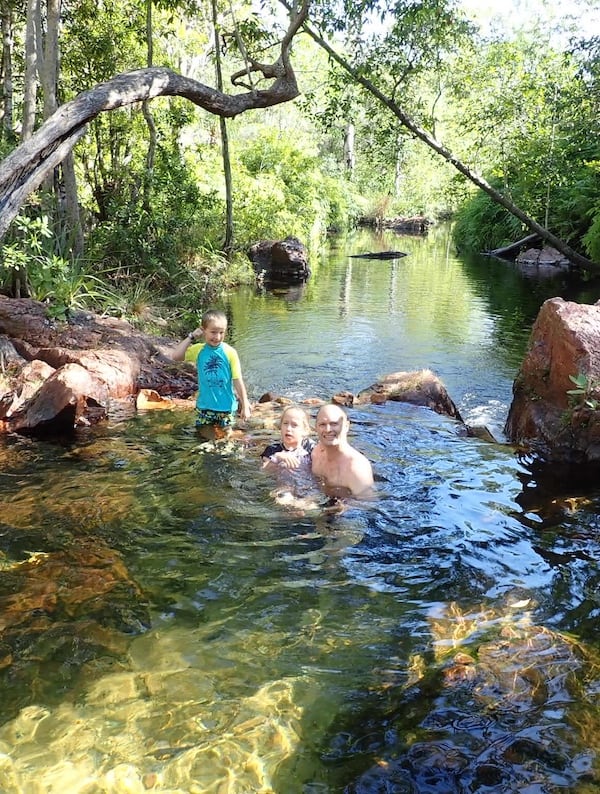
As it was empty and plenty beautiful, we decided to save our time and energy for exploring the rest of the park and settled in for a swim.
Camp 6 is around a 1-kilometer walk from the car park, so none of them are very far.
Wangi Falls
This large swimming hole with towering waterfall is just a 5-minute walk from the car park, making it one of the most popular waterfalls in Litchfield. There are toilets and changing facilities here.
Bring a pool noodle or inflatable for the kids as it’s quite a distance across the swimming hole.
Buley Rockhole
Buley Rockhole was one of our favourite stop-offs in Litchfield National Park. Just a 5-minute walk from the car park brings you to a selection of cascading rock pools.
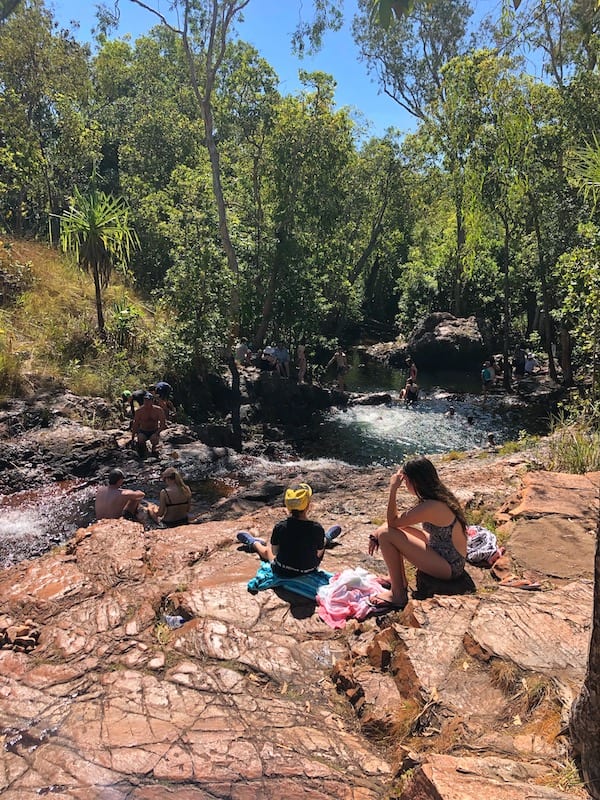
From shallow ones to wallow in, to larger ones you can jump into from the rocks, there’s a swimming hole to suit everyone here. There are even more swimming holes to choose from along the 1.5km walk towards Florence Falls.
Florence Falls
This spectacular swimming hole has two high cascading waterfalls plunging into it and clear deep water, with lots of fish for snorkelling. There is a choice of walks to get the falls, we really enjoyed the 900m Shady Creek Walk.
To read more about all of these waterfalls, read our article Litchfield National Park Waterfalls.
Litchfield National Park Termite Mounds
Beyond the waterfalls, Litchfield National Park is famous for its impressive termite mounds – and they certainly are impressive!
There are hundreds of these, everywhere you look, and some of them are enormous.
There are two types of termite mounds to look out for here – the towering cathedral mounds, which are the traditional looking termite mounds, and the fascinating magnetic termite mounds that are pretty cool and unique.
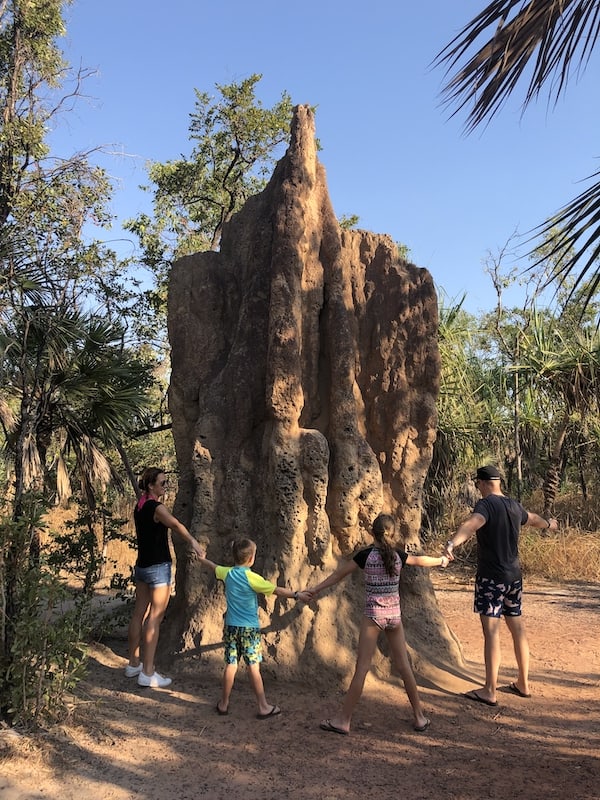
These magnetic termite mounds are endemic to Northern Territory so don’t miss the opportunity to check them out. When you first spot a large number of them together they resemble a graveyard, and when you take a closer look you’ll see why:
They are built to be tall and flat (like gravestones) and they all point in the same direction: running on a north-south axis, hence their name.
This allows the termite mounds to absorb warmth from the sun in the morning and evening (from the east and west), while avoiding the direct overhead midday heat.
Isn’t nature amazing?
Where to Stay in Litchfield National Park:
There are plenty of campsites in Litchfield National Park, including at all of the waterfall areas mentioned above. Beyond camping, Litchfield National Park accommodation is fairly limited.
If you have your own caravan, the only campsite permitted to use is Wangi Falls, and note that there are no powered sites here. There are a couple of tourist parks though, which provide powered sites and also cabin accommodation and these are listed below.
Litchfield Tourist Park
The closest accommodation to Litchfield National Park is Litchfield Tourist Park, which offers a range of accommodation options, including powered and non-powered sites for both camping and caravans.
Other accommodation on offer here ranges from basic bunkhouses to two bedroom cabins, with air-conditioning, TVs, fully fitted kitchens and large verandahs with BBQs and ceiling fans.
Facilities here include a café, swimming pool, laundry facilities and guest BBQ area.
Click here to check prices for the Litchfield Tourist Park.
Batchelor Holiday Park
The Batchelor Caravan Park is a further 10 minutes down the road and also offers powered and non-powered sites for camping and caravans, as well as cabins and villas with private bathrooms.
The two-bedrooms villas are best for families, with fully fitted kitchens and dining/living areas, air-conditioning and TVs. Within the holiday park there is a small swimming pool, mini golf, laundry facilities and BBQs.
Click here to check prices for the Batchelor Holiday Park.
Map of Litchfield National Park
Day 2: Nitmiluk National Park, Edith Falls & Katherine Gorge
Day two of our itinerary took us to Nitmiluk National Park, most famous for Katherine Gorge. We started off with a swim in the beautiful Edith Falls, before heading on to Katherine Gorge for some kayaking,
Edith Falls
Edith Falls is a spectacular swimming hole within Nitmiluk National Park. Here you have the choice of two swimming areas – the lower plunge pool and the upper pools.
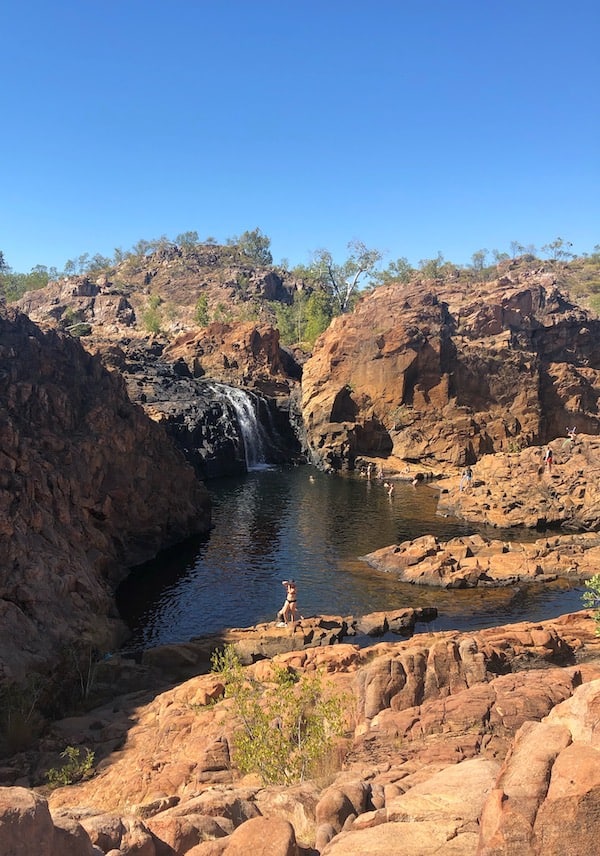
To reach the upper pool, you follow the 2.5km Leliyn Loop walk. You need to allow around 1.5 hours for the return walk but I definitely recommend this if you have time. The upper pool is spectacular and the views from behind the swimming area are worth the climb.
Katherine Gorge Kayaking
With its towering sandstone cliffs and resident crocodiles, Katherine Gorge is the highlight of Nitmiluk National Park. There are two ways to explore Katherine Gorge: by sightseeing boat or by kayaking, and I definitely recommend the kayaking option.
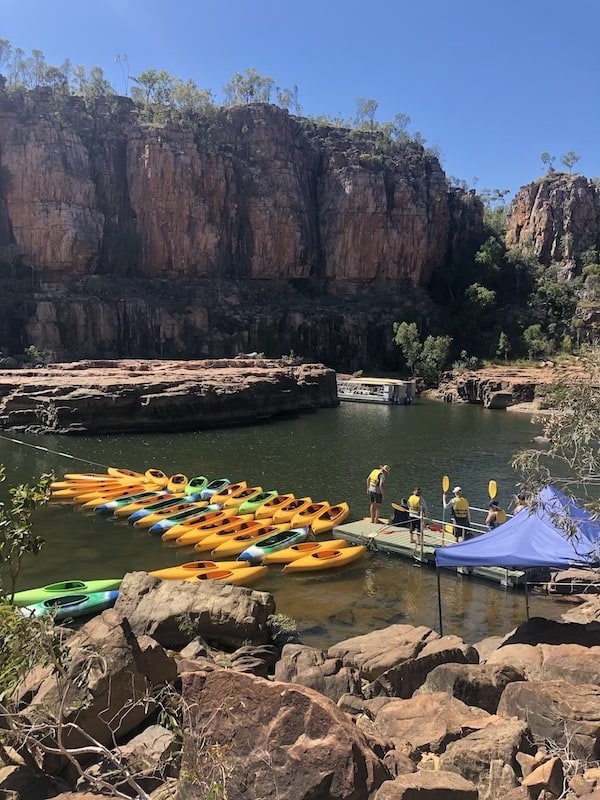
For kayaking, you can choose from a full day tour that departs at 8am and the half-day tour that departs at 1pm. We took the half-day option, which I think was enough for our family with two young kids.
There are 16 gorges in total at Katherine Gorge. On the kayaking trip, the boat drops you at the top of Gorge 1 and you then have 3 hours to explore the other gorges.
This really is a spectacular way to enjoy the stunning scenery here, floating along in peace surrounded by kingfishers, snake-neck herons and yes, even the odd freshwater crocodile!
In our three hours we managed a leisurely kayak along gorges 2 and 3, including time for a lunch stop. (Don’t forget to pack a picnic!)
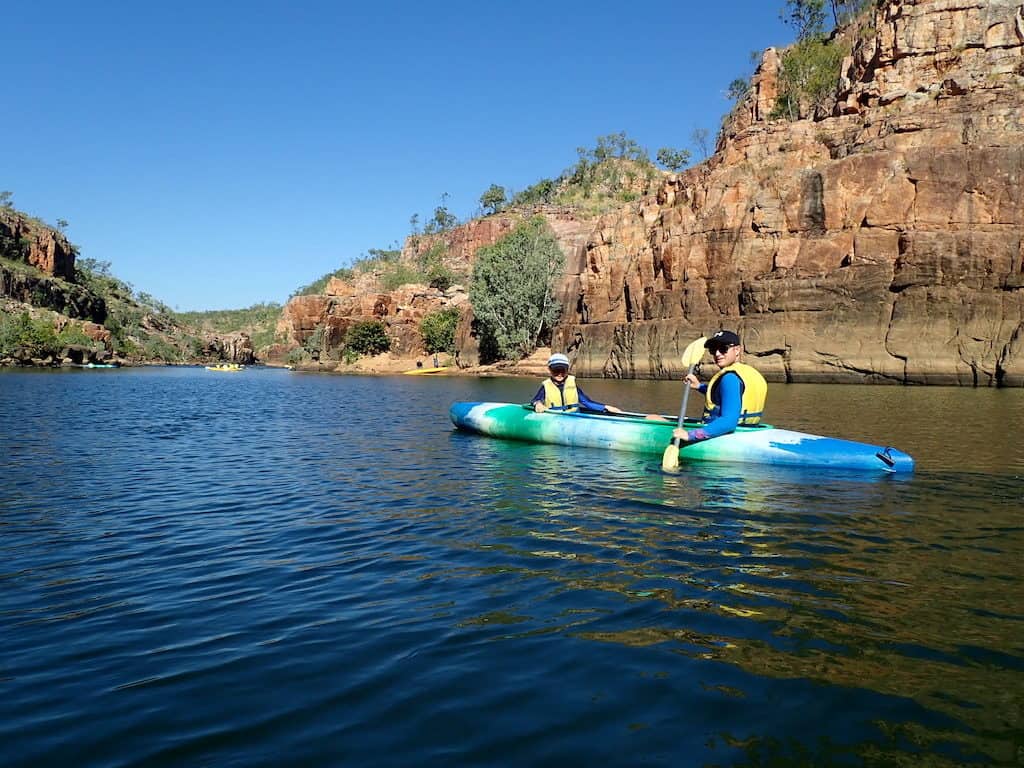
We spoke to people who were on the full day tour, and they had managed to get to gorge 6. Just make sure you turn around in time to catch the 5.30pm boat back to the gorge headquarters!
Note: if you want to make the 1pm tour on Katherine Gorge, you need to make sure you leave Edith Falls by 11.30am at the latest.
Where to stay in Nitmiluk National Park
There isn’t a huge choice of accommodation Nitmiluk National Park but if you are looking for Katherine Gorge accommodation, here are a couple of recommendations:
Cicada Lodge
Renowned as the best place to stay in Nitmiluk, people arrange their entire itineraries around staying at Cicada Lodge!
This famous lodge close to Katherine Gorge offers elegant comfort in an eco-friendly environment. Each of the 18 rooms has air-conditioning and private balconies opening onto native bushland.
Facilities within the lodge include a swimming pool and onsite restaurant, which is renowned for it’s chefs menu that incorporated local produce and unique dishes.
Space is limited at this Nitmiluk hotel, so book ahead to avoid disappointment!
Click here to check prices and availability for the Cicada Lodge.
Nitmiluk Chalets
For a more affordable option of accommodation in Nitmiluk National Park, these chalets have a fantastic location just 600 metres from the boat departure point on Katherine Gorge.
These two bedroom self-contained chalets can accommodate up to 5 people and each has a private decking area, air-conditioning and full kitchen facilities.
There is a swimming pool and BBQ facilities within the grounds and also an onsite café.
Click here to check prices and availability for the Nitmiluk Chalets.
Map of Nitmiluk National Park
Day 3: Katherine Hot Springs and Gunlom Falls, Kakadu
After an early morning dip at the Katherine Hot Springs, we set off to Kakadu National Park to explore some of the swimming holes and waterfalls of the famous Australian national park.
Katherine Hot Springs
The perfect start to your day in Katherine is a dip in the hot springs. These natural thermal springs are gorgeous.
There is a choice of pools, and you can float down the creek from one to the other, and there’s even a small waterfall to slide down.
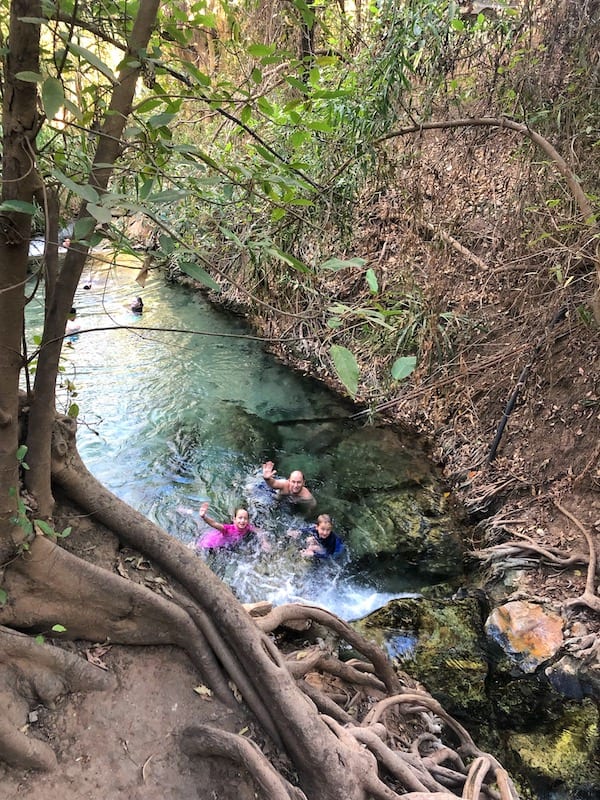
At a temperature of around 25-30 degrees Celcius, they are not really all that hot, but they are perfect for wallowing in on a cool Northern Territory morning.
There is also a pop-up café just near the entrance to the hot springs where you can enjoy an alfresco breakfast before or after your soak in the hot springs.
The springs are open every day 7am-7pm (wet season may affect these opening times).
Kakadu National Park
We were excited to cross into Kakadu National Park, after all it was the main reason we were visiting the Top End. At 20,000 square kilometres, Kakadu is Australia largest national park and one of its most famous too.
Kakadu really is a special place, being one of just 20 UNESCO World Heritage sites to be listed for both cultural and natural values by the United Nations.
From a natural viewpoint, Kakadu protects six of the major habitats of Australia’s Top End, including mangroves, floodplains, rivers, billabongs, lowland woodland, mangrove vine forests and coastline, all home to a huge number of animals and birds.
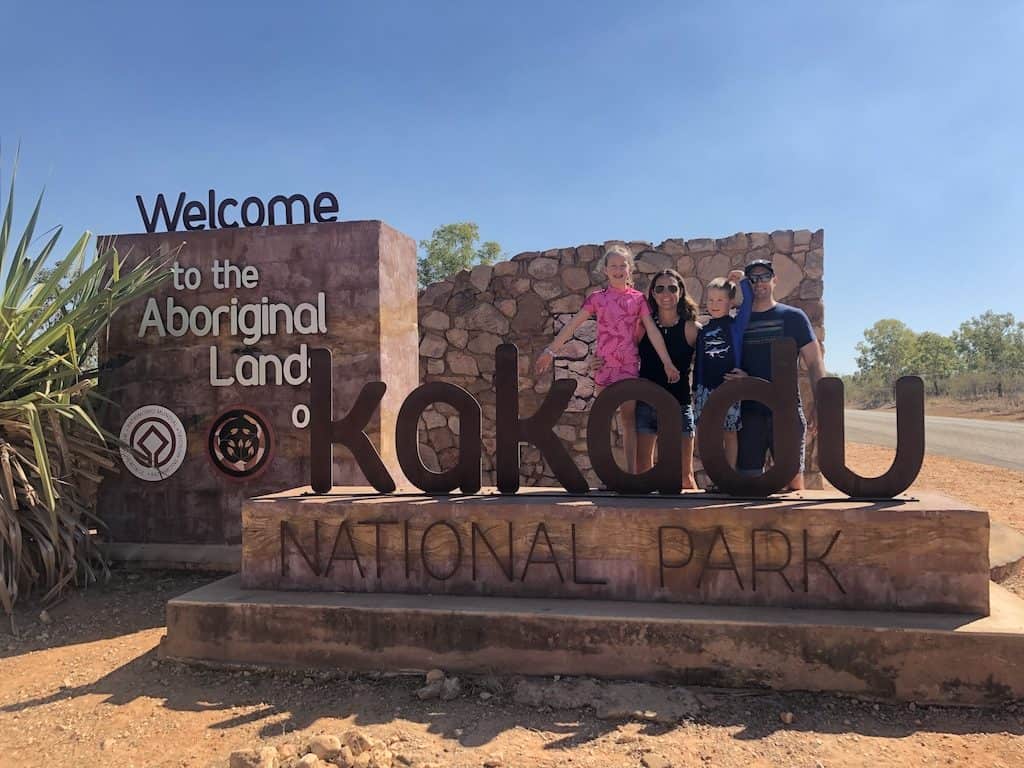
From a cultural perspective, Kakadu is famous for its incredible Aboriginal Rock Art that dates back as far as 20,000 years.
It is also now believed to be Australia’s oldest human habitation site. Archeologists recently found evidence at rock shelter Madjedbebe that puts human existence here as far back as 65,000 years!
There is therefore so many incredible sights in Kakadu National Park, and we will touch on some of them in this section of our Kakadu itinerary.
If you are heading into Kakadu along the Kakadu highway, you can call in at the Mary River Roadhouse just before the park boundary to fill up on petrol and supplies in the shop and use the washroom facilities.
The Mary River Ranger Station is just further along the road after you enter the park.
Moline
You need an extra permit to visit Moline, but if you are looking for a quiet little waterhole away from the masses with a chance of having it all to yourself, this is it.
You will need a sturdy 4WD vehicle to get to this Kakadu swimming nole as the road is pretty rough along here.
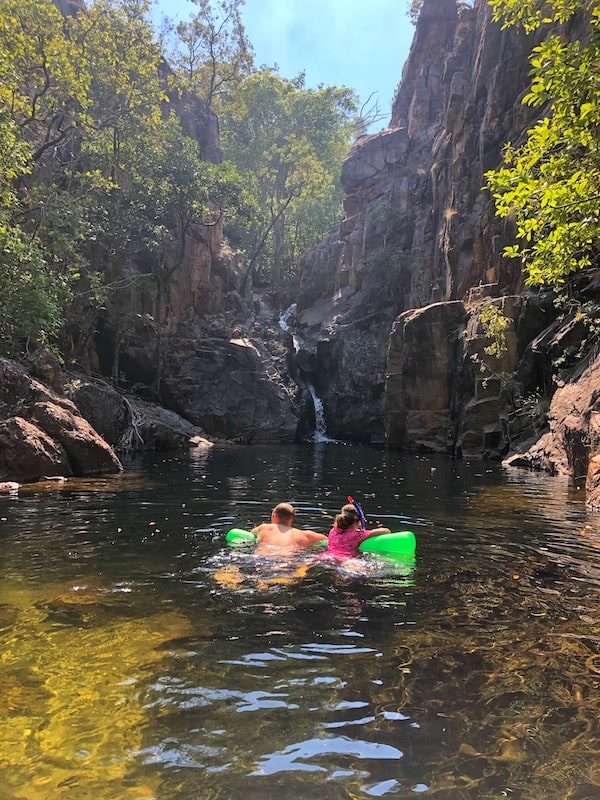
The track also isn’t signposted (and it doesn’t feature on Google Maps!), so you will need to call in at the ranger station to ask for directions. The turn-off is around 5km after the Mary River ranger station.
As this is an Aboriginal dreaming site, you are only allowed to swim in the bottom swimming hole. Please don’t attempt to climb up to the top.
Gunlom Falls
Next up is a visit to the stunning Gunlom Falls, one of the most spectacular waterfalls in Kakadu National park and often featuring on brochures and adverts.
Gunlom Falls is the perfect stop for lunch, with its lovely grassy picnic area with picnic tables, rubbish bins, toilets and changing facilities.
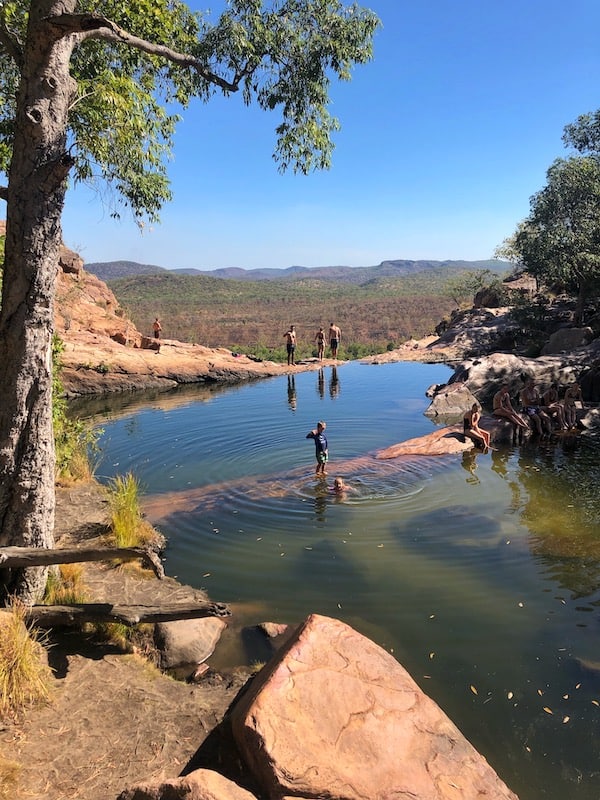
You have a choice of two swimming areas at Gunlom Falls. The lower pool is easily reached via a short boardwalk from the car park and picnic area. Here you’ll find a large open swimming hole, with easy entry and a shallow area perfect for kids to splash about in.
I definitely recommend making the hike up to the upper pools though. They are truly spectacular with incredible views over the surrounding countryside.
It is a fairly steep climb up the hill, with a bit of scrabbling over rocks required, but it is easily doable. Even with an 8-year old and 6-year old it only took around 30-minutes to get up to the upper pools.
And I promise you it is worth it.
Day 4: Aboriginal Rock Art – Arnhem Land & Ubirr Rock
Today is all about exploring ancient Aboriginal rock art. First we drive out of Kakadu to neighbouring Arnhem Land and then visit Ubirr Rock, one of the most famous rock art sites in Australia.
Cahill’s Crossing
In order to get to Arnhem Land from Kakadu, you need to drive across Cahill’s Crossing, also known as “the world’s deadliest crossing”.
This water crossing is renowned for cars being washed off the road and into the river, which would be bad enough in itself…
BUT you have to add to this that the river you are crossing here is the East Alligator River, which just happens to be home to hundreds of saltwater crocodiles!
Check out the video below to learn more about this famous water crossing in Australia:
It’s pretty cool to drive across here and spot all the big crocs in the water. But do make sure you are not attempting to cross at high tide. The danger is real!
Click here to check tide times for crossing Cahill’s Crossing. The crossing is usually closed during wet season (December – May).
Arnhem Land
Arnhem Land is known as one of Australia’s last true wilderness areas and boasts a spectacular natural landscape. Arnhem Land is home to the traditional landowners, the Yolngu people and a special permit is required to visit.
Most permits will only permit you to go to your exact destination. This means no stopping en route or diverting from the main route to get there. However, be sure to slow down now an again to appreciate your incredible surroundings.
The area is teaming with wildlife, including the famous Jabiru stork and, of course, crocodiles.
Click here for more information and to apply for a permit to enter Arnhem Land.
Injalak Art Centre & Rock Art
Our reason for visiting Arnhem Land was to visit Injalak Arts and the amazing rock art galleries of Gunbalanya.
The Injalak Art Centre is a non-profit Aboriginal-owned social enterprise that supports over 200 local Aboriginal artists. They have a fantastic shop here and you can also visit their screen printing workshop and watch some of the artists in action around the centre.
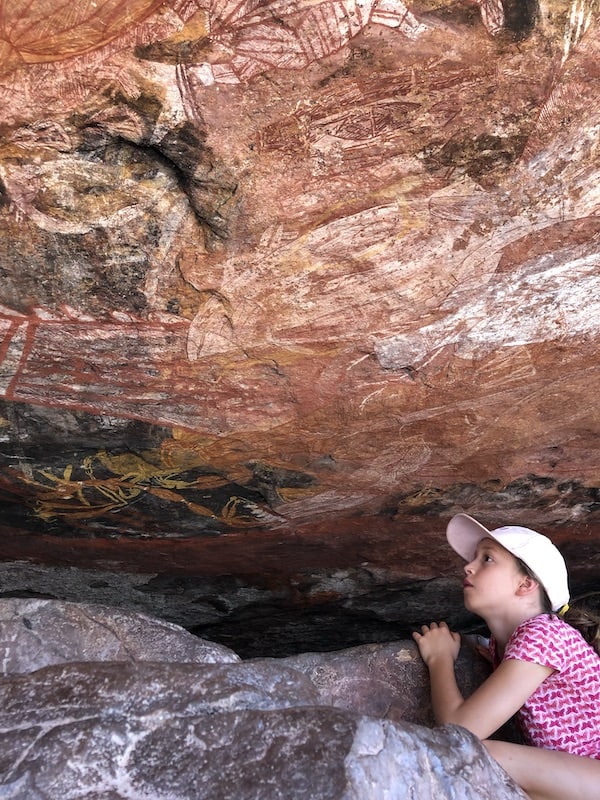
But the real highlight here is taking a rock art tour up onto Injalak Hill. I cannot recommend this highly enough. We were blown away by the scale and beauty of the rock art here, some of which is up to 20,000 years old!
Our local indigenous guide Tony took us scrambling over rocks, squeezing through crevices and ducking under overhangs, admiring hidden rock art galleries along the way. We were also privileged to be shown a traditional burial ground and were greeted with outstanding views from the top of the rock.
Just incredible.
Click here to read more about the Injalak Arts Centre.
Lunch at Ubirr Border Store
As you cross back into Kakadu National Park, the Ubirr Border Store is right there and is a great stop off for lunch before continuing on with exploring Kakadu.
The food is surprisingly good for a little outback outpost, with a fantastic selection of Asian and Thai dishes and refreshing crushed ice drinks.
Ubirr Rock
The Rock Art at Ubirr Rock is considered some of the best in the world and is one of the reasons Kakadu National Park has UNESCO heritage status.
A signposted walking trail takes you around the rock art, with informational boards to explain what you are seeing.
Keep a look out for x-ray paintings (where you can see intricate bone structures and organ illustrations of fish and other animals) as well as ‘contact’ art, which depicts the indigenous population’s first encounters with Europeans.
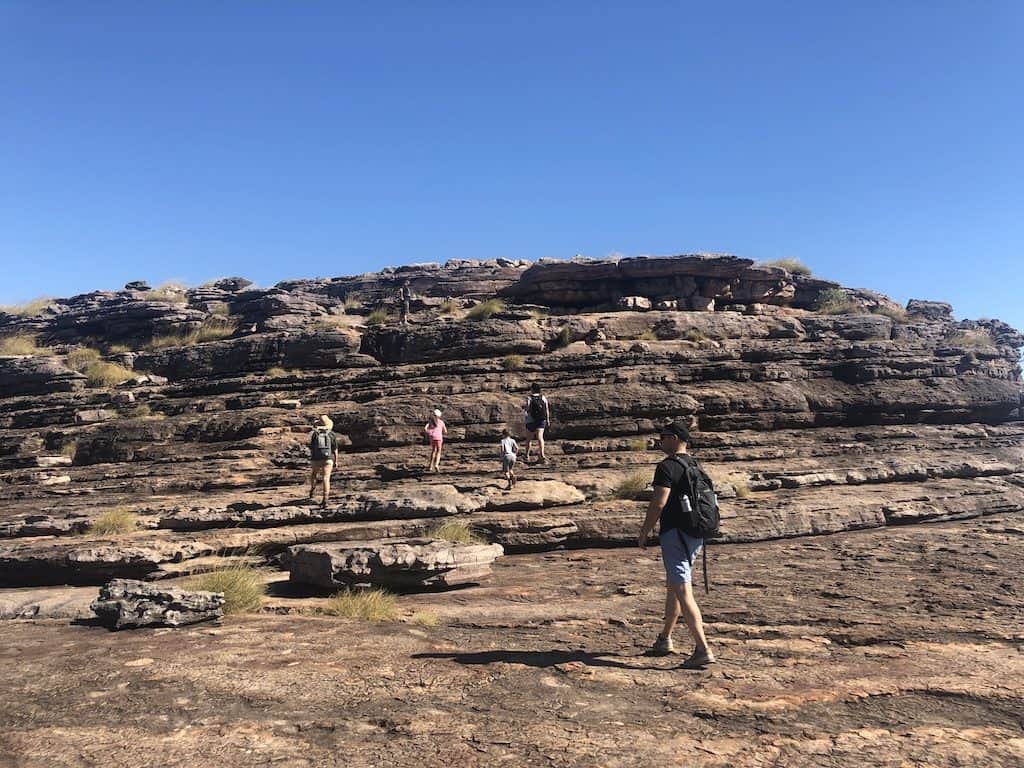
To get the most out of your experience, try to co-ordinate your visit with a ranger guided tour. The rangers can really add depth to the stories depicted on the boards and give you are great understanding of the history and culture of the area. You can check the schedule here.
The 360-degree views from the top of Ubirr Rock are incredible so be sure to follow the walkway all the way up to the top. If you are a Crocodile Dundee fan, you may recognize this view as where Mick shows off “my backyard”.
Nawurlandja Lookout
We were all pretty tired after a long day of exploring, and we nearly skipped the walk up to Nawurlandja Lookout. Boy was I glad we didn’t!
This was probably my favourite viewpoint in the whole of our trip.
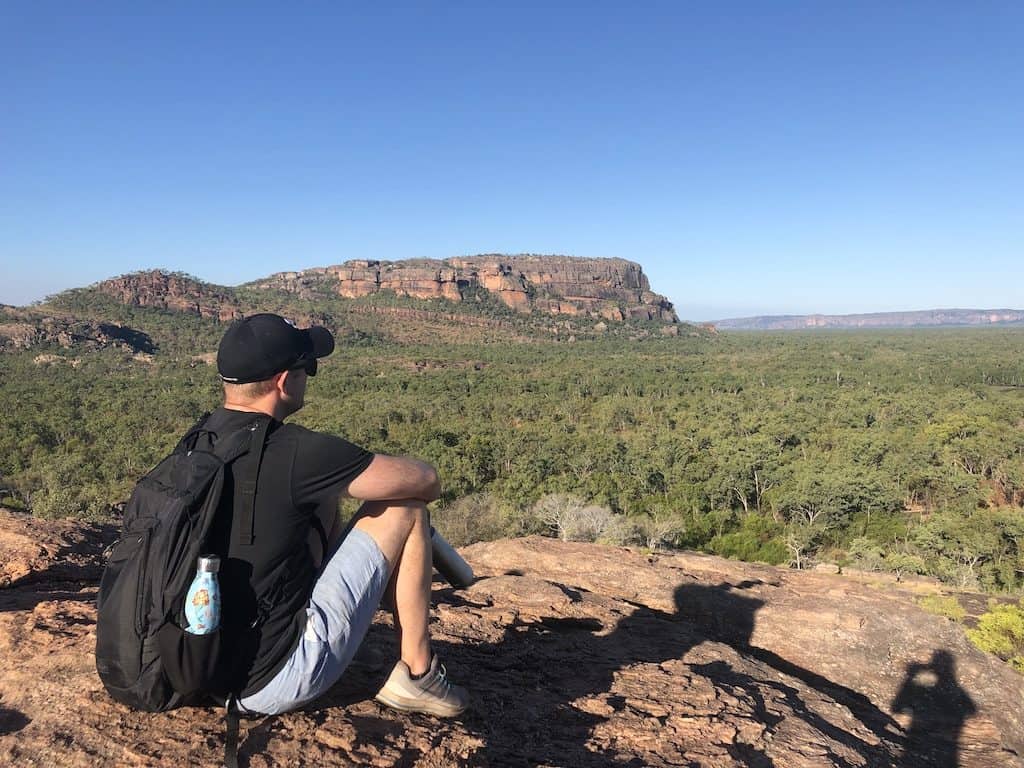
It’s a short steep climb up the hill to the lookout and the views from up here will blow you away. The vast scale of the surrounding countryside is incredible, and it will make you feel very small!
If you have enough energy to hang around, Nawurlandja Lookout is a popular spot for sunset in Kakadu. Unfortunately we were exhausted and keen to get back to our accommodation by then!
Day 5: Yellow Water Billabong & Maguk
Our final day of our trip, we started with a sunrise trip on the Yellow Water Billabong, called in to the Warradjan Cultural Centre, and enjoyed a swim in Maguk gorge before heading back to Darwin.
Sunrise Yellow Water Billabong Cruise
Kakadu is renowned for its abundant birdlife and Yellow Water Billabong is where to see it its full glory. There are also a lot of resident crocodiles here.
With a third of Australia’s bird species found in Kakadu National Park, you have a chance to spot 60 of them on a Yellow Water Billabong boat ride. White-bellied sea eagles, Jabiru storks, magpie geese, pelicans and whistling ducks are just a few of the magnificent birdlife we spotted.
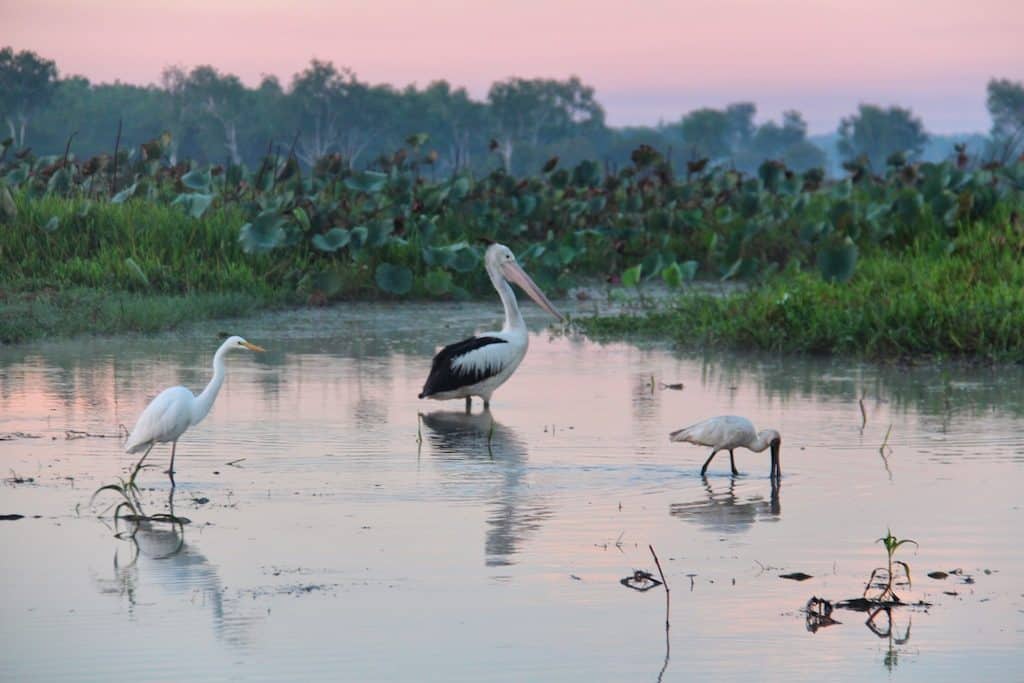
Sunrise on the Yellow Water Billabong is just magical, the colours are beautiful and the whole atmosphere is one of serenity, with just the birds and crocodiles for company.
You can do a group boat cruise, or to get away from the masses, do as we did and book a private fishing charter. Even if you aren’t that interested in fishing, it is a great way to escape the tour boats and have a slice of the Billabong to yourselves.
Yellow Water Billabong Cruises are very popular so be sure to book well in advance.
Warradjan Cultural Centre
We unfortunately didn’t have that long to spend at Warradjan Cultural Centre, but it was definitely worth the visit. We found it a great place to gain a good overall understanding of the history and culture of the local indigenous community.
Our guide was excellent and explained a lot to us and this cultural centre kind of brought it all together for me. If you are visiting Kakadu without a guide, then I would definitely recommend spending some time here absorbing all the information.
The exhibitions here have been developed by the Aboriginal traditional owners of Kakadu, with displays on bush tucker, traditional stories and personal accounts of historical events. There are also reconstructions of traditional tools and dwellings and a fabulous collection of donated traditional artefacts.
There is also a gallery shop selling traditional artwork and souvenirs and they sometimes have weaving demonstrations outside too.
Maguk Falls
Our final stop in Kakadu before the long drive back to Darwin was Maguk, also known as Barramundi Gorge.
It’s another beautiful Kakadu waterfall and swimming hole and is worth calling in at to stretch your legs and cool off before you get back in the car.
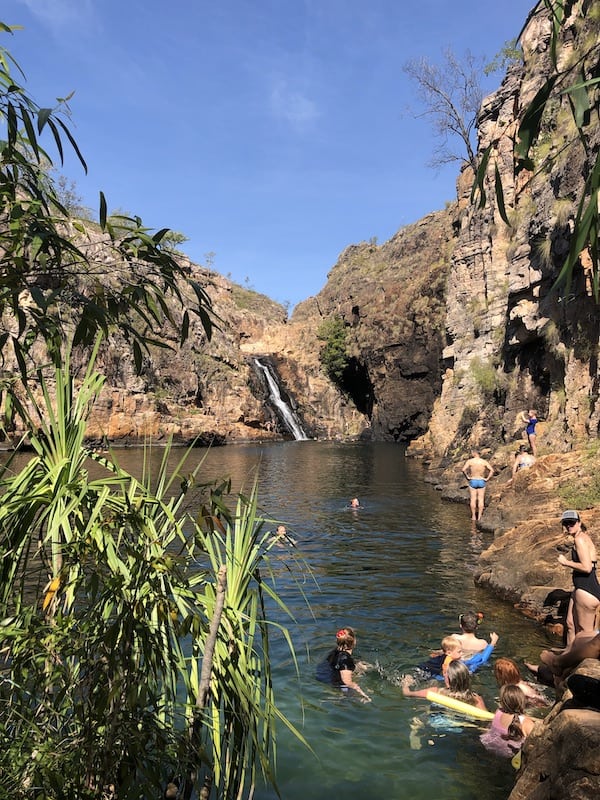
To get the swimming area, you need to do a bit of a bush walk and scramble over some rocks, but it is worth it when you arrive at the large natural swimming hole with stunning waterfall.
The water is very deep, so jumping off the rocks into the water is a popular activity and there is also plenty of fish life, so bring a mask and snorkel. The swim across to the waterfall is quite far, so bring a noodle or inflatable for younger kids.
There are toilets in the car park here, but not at the swimming area, so use the facilities before you head off on your walk.
Where to stay in Kakadu National Park
Apart from the numerous Kakadu campsites, there are two main options for accommodation in Kakadu National Park: Cooinda Lodge and the Crocodile Hotel in Jabiru.
Cooinda Lodge
Located right next to Yellow Water Billabong, the 3-star Cooinda Lodge offers a choice of accommodation: Superior rooms and family motel rooms offer air-conditioned comfort with ensuite bathrooms and TVs, while the glamping tents, which we stayed in, offer something a bit different.
These permanent tents are beautifully appointed with comfortable beds, air-conditioning and a fridge. Our family tent had a little annex with a bunk bed, which the kids thought was super cool!
These Kakadu glamping tents don’t have their own ensuite bathrooms, but the shared bathroom block is right next-door and has clean facilities with hair dryers and washing machines.
Within the the lodge ground you will find two swimming pools, a large alfresco bar/bistro, indoor restaurant, mini-mart, souvenir shop and tour booking desk. There is also a petrol station.
Click here to check prices and availability for Cooinda Lodge.
Crocodile Hotel Kakadu
The 4-star Mercure Crocodile hotel in Jabiru offers a slightly more modern and upmarket option… and yes it is actually shaped like a crocodile!
For families, this Kakadu has rooms with 2 x double beds or 1 queen and 2 x singles.
Facilities include a large outdoor swimming pool and full meeting facilities and onsite restaurant Escarpment, which dishes up both international cuisine and bush tucker.
Click here to check prices and availability for the Crocodile Hotel Kakadu.
Map of Kakadu National Park
If you have time to spend in Darwin before heading off on your road trip, then you can read all about fun things to do in Darwin with kids here.
Pin it for Later!
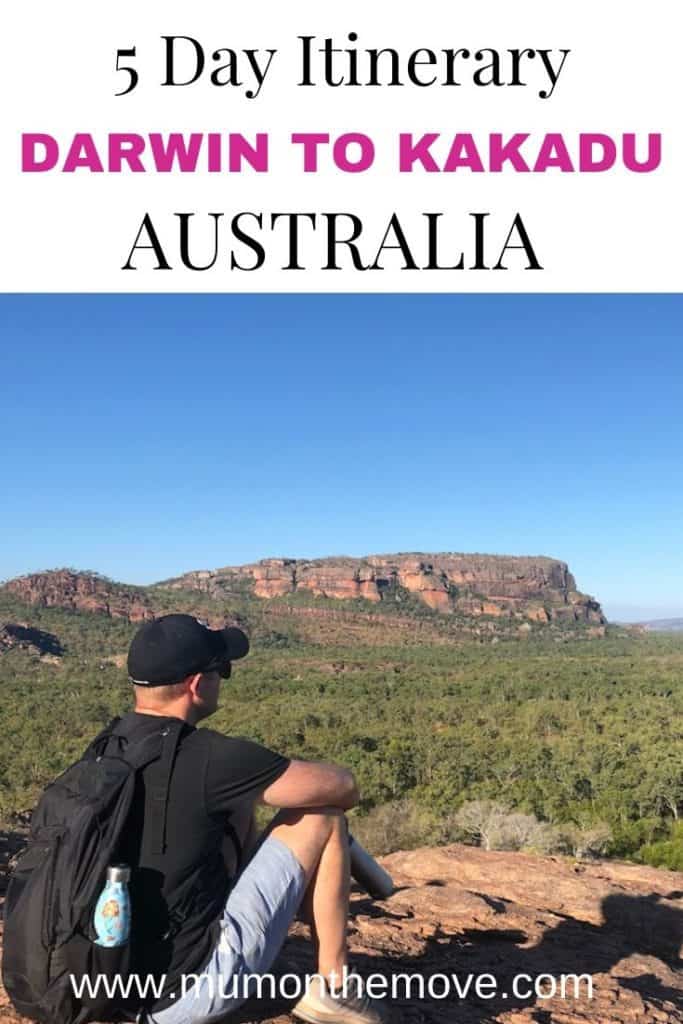
Mum on the Move is a participant in the Amazon Services LLC Associates Program, an affiliate advertising program designed to provide a means for sites to earn advertising fees by advertising and linking to Amazon.com
This post contains affiliate links. If you make a booking or purchase using one of these links, we may receive a small commission – at absolutely no extra cost to you.
